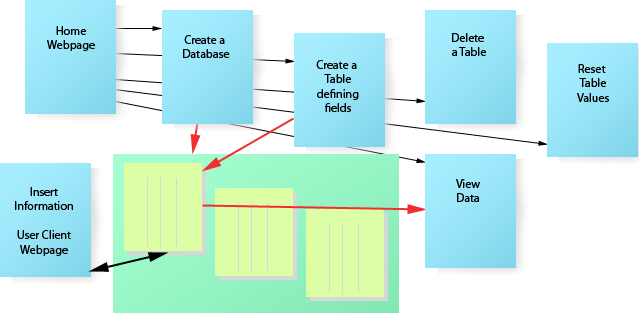CSE625 - Forms
Interactive activity, filling in forms
Web2.0 is identified as an interactive web, a web where user clients can enter information and the web, the Internet, responds back. one way that thing may happen is with forms. Some form applications are obvious, such as when the web asks for you name and address and other information which we typically see on a paper form. Others are less obvious such as a search box, username and password boxes and even using blogs, Facebook, and other social networking websites and banking online.
We will look into some basic forms, the building blocks of some of the forms we use in our interaction with the web. One cruel sample will be creating a database with a table. The other sample will again use a database and table to allow others to comment on a webpage, similar to a blog.
In either case it is necessary for there to be webpages to be used only by an administrator who sets up the database and tables and can manage these tables. There will also be at least one webpage where the client user can enter their information.
Creating the code for a blog
In this sample we will create seven webpages with a couple php documents to be included in all the webpages. For the administrator we will create a home webpage with links to the webpages necessary to manage this system of webpages. There will be a webpage to create the database which in fact at WOU has already been done for us. There will be a webpage to create the table and define the fields in the table. There will be a webpage to delete the table, and one to reset the values. There will also be one to view the table with the raw data in the table.
Finally there will be one public webpage which the user client will view and where they may enter information. The URL of this final webpage is the only address that will be provided to the public or user clients.

A home page setup for the administrator. This page has links to the other webpages that will be used to mange the database and tables. For example: http://www.wou.edu/~saxowsd/tech2/eden/amind/cse625/dbtesting/denhome.php
A webpage used the administrator to create a database on the server. This has been already done in this case by the university.
A webpage used the administrator to create a table or tables in the database. In this case we as a class have some control over this table or tables. When creating the table the administrator will define the fields in the table, such as name, address, email address, comment, date, and a primary identification for each record.
A webpage used the administrator to delete the table if necessary. This is non-retrievable and so do this carefully and only before you allow the user client to see their page.
A webpage used the administrator to reset the information in the table. The coding of this webpage may change depending on what the administrator wishes to do.
A webpage used the administrator to view the raw data in the table so other webpages may be developed to manage the data.
Finally and most importantly, or at least from the point of view of the user client and the goal of this project, the page where the user client views the webpage and is allowed the opportunity to enter information. This page can vary greatly depending of the purpose of the page.
A very basic sample of the managing a database
Several pages of the codes are for an administrator to setup the process, one is for the client or user to enter the information, and one is for the administrator or a recipient to receive the data.A login page setup for the administrator. A similar page could be setup for the client and for the recipient.
http://www.wou.edu/~saxowsd/phpa/1cse625logina.html
A login page setup for the administrator. A similar page could be setup for the client and for the recipient.
http://www.wou.edu/~saxowsd/phpa/1cse625logina.html
A page which creates the database and is connected to the login page since the create page cannot be accessed without the proper password from the administrator.
http://www.wou.edu/~saxowsd/phpa/2cse625createa.php
A page with a form that the user will complete to submit information. .
http://www.wou.edu/~saxowsd/phpa/2cse625dataforma.php
A page that inserts the information into a database that is connected to the form page and transparent to the user.
http://www.wou.edu/~saxowsd/phpa/3cse625inserta.php
Lastly a page to be used by the administrator or a person designated to receive the information..
http://www.wou.edu/~saxowsd/phpa/4cse625printa.php
